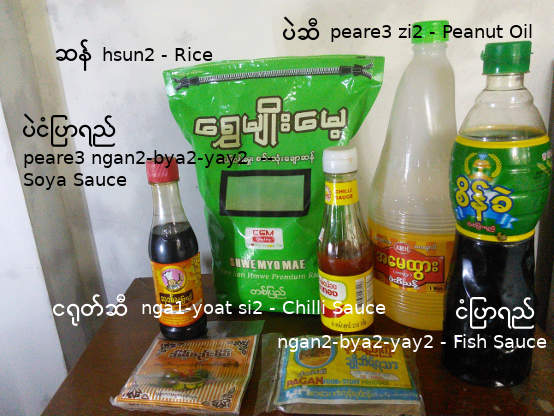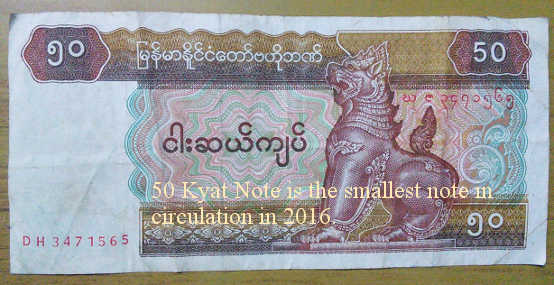Buying Meat, Fruits, Vegetables, Eggs & Bread
If you decide to live in Yangon for an extended period like a number of foreign businessmen, sooner or later you will need to do some grocery shopping on your own. There are a number of supermarkets in Yangon like Ocean Supermarket, City Mart, and AEON Orange where you don't need to speak anything. However, if those supermarkets are not in the vicinity of your home, it will be much more convenient to rely on your neighborhood shops and markets to buy fresh fruits, meat, vegetables, bread and eggs.

The Burmese word for market is
zay3.
![]()
If you can't go to zay3, then it will come to you. In many residential areas, the sellers go around the neighborhood with a big basket of meat, fish, and chicken balanced over their heads. Some fruits and vegetables sellers use trolley carts to push around the streets and cry out what they are selling using their trademark sales pitch.
You may not always understand what they are shouting even if you know some Burmese. Even Burmese like me sometimes don't know what they are shouting. In one case, I heard someone selling
ga1-nun3 dway2.. ga1-nun2 dway2..
I ran out to catch the seller expecting some fresh or cooked crabs but it turned out to be the print out results of the state lottery.
ga1-nun3 in Burmese also means "numbers".
If you don't know what's inside the basket, just ask:
ba2 - What
pa2 - accompany
leare3 - ?
ba2 pa2 leare3
What are you carrying? What do you have there?
(what + accompany + ?)
The respond will be something like:
kjet tha3 pa2 deare2...
I have chicken... (chicken + accompany + affirmation)
nga3 pa2 deare2...
I have fish... (fish + accompany + affirmation)
wet tha3 pa2 deare2...
I have pork... (pork + accompany + affirmation)
You may still not understand the person if you have a limited vocabulary. Don't worry. Just say:
kji1 chin2 deare2
Let me have a look. (look + want + affirmation)
kji1 means "to look".
kji1 chin2 is the desire to look.
kji1 chin2 deare2 can also be translated as "I want to look."
But, the feeling tone is not so blunt as such. It's more like, "Let me have a look."
The seller will put the basket down and you can take a look what's inside. If whatever inside is not what you want, say:
ma1 - negative (particle)
weare2 - buy (verb)
thay3 - yet to be (particle)
bu3 - negative ending (particle)
ma1-weare2 thay3 bu3
Not buying this time.
(negative + buy + yet to be + negative ending)
If you are interested, the next logical step is to ask the price:
beare2 lo2 youn3 dtha1-leare3
How much are you selling? (How + sell + ?)
or, simply ask:
beare2 lout leare3 — How much?
Weight & Measurements

In supermarkets, kilogram is used to measure weight for meat, cooked food, fruits and other food stuff such as bags of rice. The local weight scale used in neighborhood shops and markets is called
pate-tha2
![]() — viss, which is divided into 100
— viss, which is divided into 100
kjut-tha3![]() — ticals.
— ticals.
If you buy
da1-bate-tha2
![]() — one viss
— one viss
of meat, you will get about 3.6 lb (1.6 kg), which is simply too much for a typical Burmese family who buys fresh vegetables, fish or meat almost every day. if you ask:
beare2 lo2 youn3 dtha1-leare3"
![]() — how much are you selling ?
— how much are you selling ?
the seller will reply you in terms of
kjut-tha3, which is shortened as
tha3.
Example:
a-meare3-dtha3 beare2 lo2 youn3
dtha1-leare3
How much do you sell the beef?
(beef + how + sell + ?)
chout-ya2 — 600
The price of chicken relative to beef and pork came down and cost about 700 Kyat. Pork, depending on which part, cost around 700 to 900 on the average in July 2016. The meat part without fat was around 1100 Kyat and spare ribs were 550 Kyat. The premium spare ribs with soft bones were expensive and ordered by hotels and restaurants in advance, so you would not find it in the market.
Despite the inflation which went past 8.5% in mid 2019, the price of chicken remained stable and cost about the same as in 2016.
You will get the same answer if you ask:
ta1-hseare2 dtha3 beare2 lout leare3
How much for 10 tha3 ?
(10 + ticals + how much + ?)
Sometimes, you may hear the word ba2 appended to the answer to soften the tone.
chout ya2 ba2 — Oh, it's 600.
Please refer to Lesson 2 for the use of the word "ba2".
Unlike in the supermarkets, fruits and some vegetables in neighborhood markets are sold in quantity, bunches, or in bundles.
Examples:
tha1-yet thi3 beare2 lo2 youn3
dtha1-leare3
How much do you sell the mangoes?
(mango + how + sell + ?)
thone3 lone3 ta1-htoun2
3 for 1,000. (3 + unit for fruits + 1 + thousand)
kjet u1 beare2 lo2 youn3
dtha1-leare3
How much do you sell the eggs ?
(chicken + egg + how + sell + ?)
ta1-lone3 ta1 ya2 ba2
1 for 100. (1 + unit for eggs + 1 + hundred)
mone2-nyin3 beare2 lo2 youn3 dtha1-leare3
How much do you sell the mustard greens?
(mustard greens + how + sell + ?)
thone3-zi3 hna1-ya2 ba2
Oh, its 200 for 3 bundles.
(3 + bundles + 2 + hundred + polite ending word)
2016 Updates: Roselles (chin2-boun2) are most affordable with 50 Kyat a bundle, while watercress (ga1-zoon3 ywet) are fresh and abundant at 100 Kyat a bundle. Djenkol bean (da1-nyin3-dthi3) is 50 each. Those three are luxury items for Overseas Burmese people who are dying to have those, and pay high price in some other countries if available at all.
2019 Updates: Mustard greens are 100 for 1 bundle.
Although the phrase:
beare2 lo2 youn3 dtha1-leare3
sounds more colloquial for an item that the seller can mark up the price and sell it as he or she wishes, the phrase
beare2 lout leare3 - How much?
sounds more natural for items with more or less fixed prices, such as bread that is distributed by the wholesaler.
poun2-mone1 beare2 lout leare3
How much is bread ? (bread + how much + ?)
How much for any item?
If you don't know the name of the item or its measure word (unit) in Burmese, there is an easy way out:
da2 beare2 lout leare3
How much is this? (this + how much + ?)
Poultry, Beef, Pork, & Seafood
You are almost certain to get
nga3
![]() — fish
— fish
everyday from the neighborhood shops and sellers who go around the residential areas. In special occasions, Burmese people
poun3 — steam
nga1-tha1-lout — hilsa fish
for several hours until bones are tender and can be eaten. If you want to try out the taste of
nga1-tha1-lout poun3
![]() — steamed hilsa
— steamed hilsa
you can buy it in the canned food sections of the supermarkets (and even in neighborhood shops) on the same shelves as tuna and sardine.
Hilsa is found in the rivers of Myanmar and Bangladesh. It is oily and somewhat like Salmon. Polyunsaturated fatty acids found in Hilsa is healthful for human consumption just like Salmon fish. Contrary to popular Burmese belief, a study has shown that eating Hilsa will not increase the blood pressure (because its oily) , but will reduce the cholesterol level. Here's a link:
ncbi.nlm.nih.gov/pubmed/7880151
Average Burmese will be familiar with
nga3-thit-ta2 nga3
![]() — sardine
— sardine
both fresh and in tin cans, but imported tuna is much more expensive, and can only be bought in tin cans.
Some Burmese Buddhists avoid taking
a-meare3-dtha3
![]() — beef
— beef
which is probably an Indian Hindu tradition. Another reason could be that for generations, cows and bulls are used in the fields for growing crops and for transportation that they are considered
kjay3-zu3 shin2
(someone or something to be thankful for.)
ba1-zoon2
![]() — prawns
— prawns
and smaller
ba1-zoon2 zate
![]() — shrimps
— shrimps
are abundant in Myanmar, and you can get those fresh from the markets. There are shrimp farms in Myanmar, but since shrimp farming is a lucrative business for export with more profits, fresh seafood you get from the local markets are most likely from the rivers and coastal areas caught by the fishing boats.
beare3 dtha3
![]() — duck
— duck
is less common than
kjet tha3
![]() — chicken
— chicken
and they are often bony. However, you can easily get
beare3 u1
![]() — duck eggs,
— duck eggs,
which the Burmese use for cooking
mone1-hin3-ga3
![]() — Burmese favorite for breakfast with rice noodle in fish gravy.
— Burmese favorite for breakfast with rice noodle in fish gravy.
If you have craving for Chinese Peking roasted ducks, the best is to go to restaurants like Golden Duck where you can get ducks with more meat than bones.
There are two types of
kjet
![]() — chicken.
— chicken.
The first type is grown in big chicken farms and those come in the same size as in Western countries. Those big size chicken are called
mway3-myu2-yay3 kjet
![]() — poultry farm chicken.
— poultry farm chicken.
Second type is
ba1-ma2 kjet
![]() — Burmese chicken
— Burmese chicken
preferred by some people for its "sweet" taste.
The first type for big farm chicken is better known as
PC kjet, which by the way, is fried and barbecued chicken franchise brand name called "PC" from Thailand with outlets all over the places.
There is a Burmese saying: When it comes to meat, pork is the best; for fruit, mango is the one; pickled-tea is chosen among the leaves.
wet tha3
![]() — pork
— pork
is sold in different prices. The most expensive part is meat only without any fat. But, the price difference is not that substantial.
Interestingly, some Burmese also avoid taking pork just like Muslims. When I was young, for example, you could not
bring pork to Mount Popa because local people believed that
certain Nats (supernatural beings)
like shway2-pfyin3-ji3 and shway2-pfyin3-ngeare2 the two sons of byut-ta1 who was a Muslim seaman during King A-nau2-ra1-hta2 time disapproved of it. I am not sure if this custom has changed, but it does make sense to avoid animal fats for health reasons.
Fruits & Seasons

Myanmar has three seasons. The cooler "tourist" season is from October to March when nights are pleasantly cooler than hot summer months from April to about June. You can expect heavy rains and thunder storms from June to September. The rain seems to be heaviest around July, and then tapered off towards the end of October.
You can get
sa1-tau2-beare2-ri2
![]() — strawberry,
— strawberry,
za1-byit thi3
![]() — grapes
— grapes
pan3 dthi3
![]() — apples
— apples
kjweare3-gau3 dthi3
![]() — grapefruits
— grapefruits
and
lite-chi3
![]() — lychee
— lychee
grown in highland regions during those "tourist" seasons when the temperature could drop below freezing point in some parts of the country.
Around Christmas to Chinese New Year, you can get oranges and tangerines of different sizes, types, and names.
If you visit Myanmar during the rainy season, you can eat
tha1-yet thi3
![]() — mangoes
— mangoes
all you want, and they are not expensive like in the US or Canada. You can also get durians during summer till the end of the year. Rainy season is the season of fruits when you can have your stomach filled with
na2-nut thi3
![]() — pineapples
— pineapples
min3-goot dthi3
![]() — mangosteen
— mangosteen
au3-za2 dthi3
![]() — custard apples
— custard apples
met-moon2 dthi3
![]() — peaches
— peaches
thit-tau2 thi3
![]() — Asian pears
— Asian pears
ma2-la1-ka2 thi3
![]() — guavas
— guavas
pain3-neare3 dthi3
![]() — jack fruits
— jack fruits
zi3 dthi3
![]() — plums
— plums
and
kjet-mout thi3
![]() — rambutans
— rambutans
There seems to be two seasons for
pfa1-yeare3 dthi3
![]() — water melons.
— water melons.
You can get it in the summer till the start of rainy season, and again around October to December.
You can get papayas and bananas in all seasons. Bananas are sold by the bunch. In some small roadside shops, you can buy just one or two bananas if you don't want the whole bunch.
Grapes and a type of small size oranges called
pya3 lain2-mau2
![]() — clementine
— clementine
are weighed, and strawberries are sold by the basket or in plastic containers. Bigger fruits like durians, and pineapples are sold by a single quantity, whereas mangoes are sold in either single quantity or in the quantity of 3 or 5.
Grocery Items and Cooking Ingredients
You can get eggs, bread and grocery items in neighborhood shops and corner stores. But, be sure to stock up enough food (especially bread) before thin3-jan2 (water festival) and Burmese New Year in mid April. Shops will be opened for limited hours if not closed for a few days. Also beware of price hike ups for items like fish and meat just before the shut down.

Smaller Change
It must have been a long, long time since Burmese people last used coins. In the past, Kyat ( pronounced kjut with silent "t" ) was divided into 100 pya (pronounced pya3.) Pyas were coins, such as 5 pya, 10 pya, 25 pya, and 50 pya coins.
Due to inflation that had shot up several folds in the 1980's, the smallest denomination you see today are 5 kyat notes, and 10 kyat notes. They are sometimes stapled together in 50 kyat amount; only then they become a meaningful amount to buy anything at all, or to return as a small change. As of 2014, even those have disappeared, and the smallest note you see is 50 kyat note.
Burmese kyat notes in the denominations of 50 kyat, 100 kyat, and 200 kyat notes are considered
small changes, and called
a-kjway2.
![]()
Those small notes used to be notoriously dirty, worn-out and in sorry conditions, but in the year 2011, the government banks have started to replace those with newly printed notes.
Shopkeeper to the customer:
a-kjway2 pa2 la3
Do you have small change with you?(small change + accompany + ?)
Customer to vegetables seller:
a-kjway2 un3 nine2 la3
Are you able to return change?
(small change + to return change + able to + ?)
Here's how the question of small change should be answered:
a-kjway2 pa2 deare2
I have small change.
(small change + accompany + affirmative)
a-kjway2 ma1-pa2 bu3
I didn't bring any change.
(small change + not + accompany + negative ending)
a-kjway2 ma1-shi1 bu3
I don't have any change.
(small change + not + present + negative ending)
a-kjway2 ma1-un3 nine2 bu3
I cannot return small change.
(small change + not + to return change + able to + negative ending)
In that case, you will end up buying something extra to make the total amount closer to the multiple of 1,000 kyat notes. As a last note on the subject of small notes, don't be surprised if the shopkeeper gives you some sweets in place of the change.

